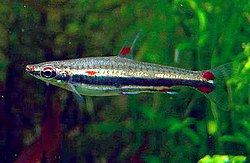Nannostomus trifasciatus
| Nannostomus trifasciatus | |
|---|---|
 |
|
| Scientific classification | |
| Kingdom: | Animalia |
| Phylum: | Chordata |
| Class: | Actinopterygii |
| Order: | Characiformes |
| Family: | Lebiasinidae |
| Genus: | Nannostomus |
| Species: | N. trifasciatus |
| Binomial name | |
|
Nannostomus trifasciatus Steindachner, 1876 |
|
Nannostomus trifasciatus, commonly known as the three-lined or three-stripepencilfish, is a freshwater species of fish belonging to the Lebiasinidae family of characins. They are popular in the aquarium trade due to their small size, beautiful color pattern, and relative hardiness.
Steindachner first described the species in 1876, making it one of the first four species in the genus to be described. As a result of the broad distribution of N. trifasciatus, the species is polymorphic and, over the years, some of these color morphs have been erroneously described as separate species. Poecilobrycon erythrurus and Poecilobrycon vittatus, two such examples, are now known to be junior synonyms.
N. trifasciatus inhabits slow-moving, slightly acidic waters. Within these conditions, it is found in several different habitat types. It has a broad distribution throughout the Amazon basin, Colombia, Peru, northern Bolivia, and the Guianas. In the Rio Negro, it inhabits the large swamps that form where tributaries meet the main branch of the river. When the river floods, it moves into the inundated rainforest. During the low-water season, it often becomes trapped in small lakes that are left behind, or stays close to the wooded edges of the forest. N. trifasciatus rests near the water surface at night and during the day inhabits the middle to upper water layers.
The three-lined pencilfish is a small fish, with adults not reaching more than 6 cm in length. It has a small terminal mouth, and an adipose fin may or may not be present. Most pencilfish possess distinct daytime and nighttime color patterns, and N. trifasciatus is no exception. During the day, it has three black longitudinal stripes that run the length of the body. At night, three large dark spots materialize on the sides of the fish, extending from its back to its belly. Research has shown that this change in coloration is due to the differential action of the pineal hormone melatonin on pigment cells in different regions of the integument. The daytime color pattern may serve an aposematic or recognition function for individuals of the same species, and the nighttime pattern may help hide the fish from nocturnal predators. In between the variable, darkly pigmented regions, N. trifasciatus is greenish-gold in color on its back and sides and silver underneath. The gill cover and dorsal, pelvic, anal, and caudal fins possess red blotches, varying in size depending on the population. N. trifasciatus has often been confused in aquarium literature with N. marginatus which is also a three-striped pencilfish; however, the latter species can be distinguished by its smaller size and blockier profile.
...
Wikipedia
